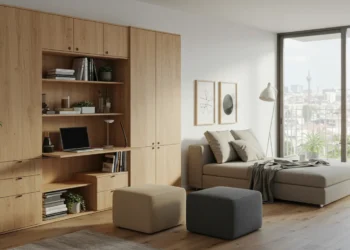Home renovations can sometimes come with a negative environmental impact, but there are ways to reduce our carbon footprint and improve the sustainability of our homes. Eco-friendly materials are a great way to make a positive change while renovating. In this article, we will discuss the top eco-friendly materials that can enhance the sustainability of your home renovation.
While considering all of these eco-friendly options for your home renovation, you may decide that it’s time to move to a new house that can better accommodate your sustainable goals. In such cases, you could choose to sell your house fast, which could help facilitate the transition to an environmentally friendly home and more responsible living.
Reclaimed Wood
Reclaimed wood comes from old buildings, barns, and other structures. It can be used for flooring, cabinetry, and even structural beams. By using reclaimed wood, we help to reduce the demand for freshly cut lumber and support recycling efforts.
Recycled Metal
Recycled metal can be used in various applications in your home, such as pipes, ducts, or countertops. Metal is a highly durable material, and using recycled metal can reduce the production, mining, and refining processes for new metal.
The Benefits of Choosing Eco-Friendly Materials
Eco-friendly materials and practices offer a range of benefits, including:
- Reduced environmental impact
- Improved air quality
- Resource conservation
- Energy efficiency
- Healthier living space
Linoleum
Linoleum is made from natural materials such as linseed oil, cork dust, and wood flour. It is biodegradable, long-lasting, and available in various designs and colors. Linoleum is a perfect eco-friendly option for flooring, countertops, and wall coverings.
Insulated Concrete Forms (ICFs)
ICFs are pre-made foam blocks filled with concrete, which provide excellent insulation for a home. They can improve energy efficiency, reduce noise pollution, and provide a durable, disaster-resistant framework for your home renovation.
Bamboo
Bamboo is an incredibly fast-growing, renewable resource. It is stronger than most hardwoods and makes for an excellent eco-friendly flooring option. It can also be used in cabinetry, furniture, and interior scaffolding.
Cork

Cork is a highly sustainable and renewable material derived from the bark of the cork oak tree. It’s an excellent choice for flooring, insulation, and wall coverings due to its insulation and impact resistance properties.
Straw Bale Construction
Straw bale construction is an excellent option for insulation and can even be used to build walls. It helps regulate temperature and moisture levels, providing energy efficiency and preventing mold and mildew growth.
Low VOC (Volatile Organic Compound) Paint
Low VOC paints emit fewer harmful chemicals into the air and help maintain better air quality in your home. By choosing low-VOC paint, you’re contributing to the reduction of air pollution and supporting a healthier living space for you and your family.
Rammed Earth
Rammed earth is a technique that involves packing a mixture of earth, water, and a small amount of cement into a form, resulting in a strong, energy-efficient, and durable material. Rammed earth walls have excellent insulation properties and provide a natural, unique aesthetic to any home renovation.
Recycled Glass Tile
Recycled glass tiles are a beautiful and eco-friendly option for your home renovation. Made from broken and recycled glass, these tiles can be used for countertops, backsplashes, or even flooring. They’re an excellent way to add a touch of color and contribute to the reduction of waste.
Solar Panels
Installing solar panels on your home not only reduces your reliance on non-renewable energy sources but also lowers your energy bills and decreases your carbon footprint. Solar panels can provide clean and sustainable energy for your household by harnessing the sun’s rays, making your renovation eco-friendly and energy-efficient.
Green Roofs
Green roofs are an innovative way to improve the sustainability of your home renovation. A green roof features layers of soil and vegetation that are installed over a waterproof membrane on your roof. This eco-friendly addition can provide insulation, absorb rainwater, reduce the urban heat island effect, and create a habitat for local flora and fauna.
Energy-Efficient Windows

Energy-efficient windows help lower your energy consumption by minimizing heat transfer between the inside and outside of your home. These windows are designed with special double- or triple-pane glass coatings, gas fills, and improved framing materials.
Incorporating energy-efficient windows into your home renovation can significantly reduce your heating and cooling costs, making your living space more comfortable and environmentally friendly.
Conclusion
Choosing eco-friendly materials for your home renovation not only benefits the environment but also supports the long-term health and comfort of your living space. By considering these eco-friendly options when planning your home renovation, you’re taking a step towards a more sustainable and responsible lifestyle.









